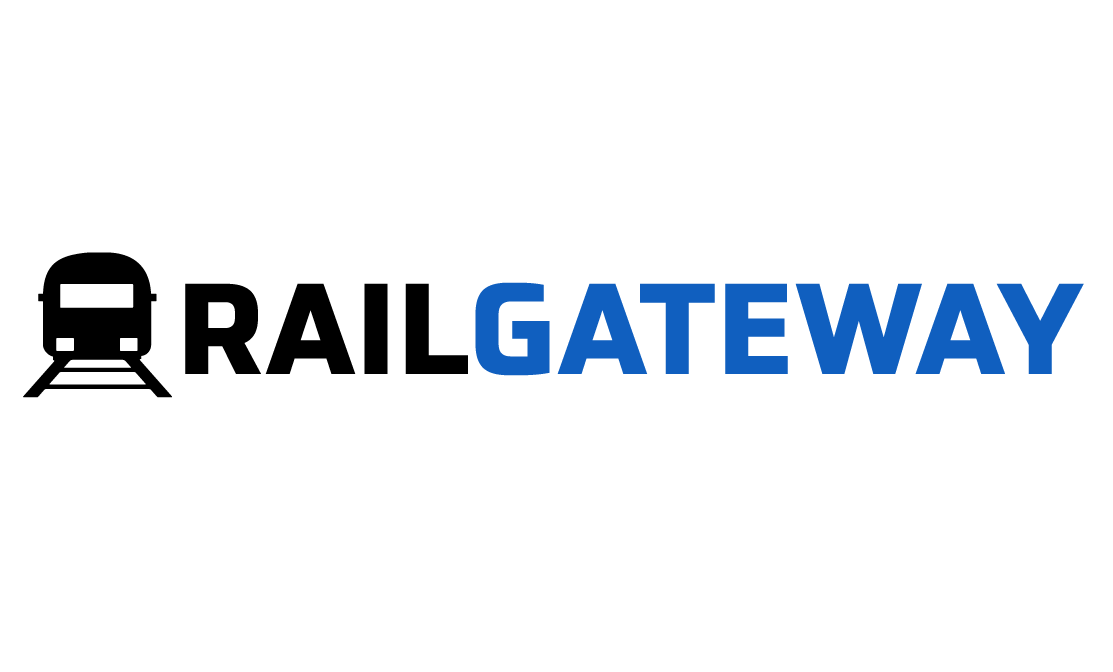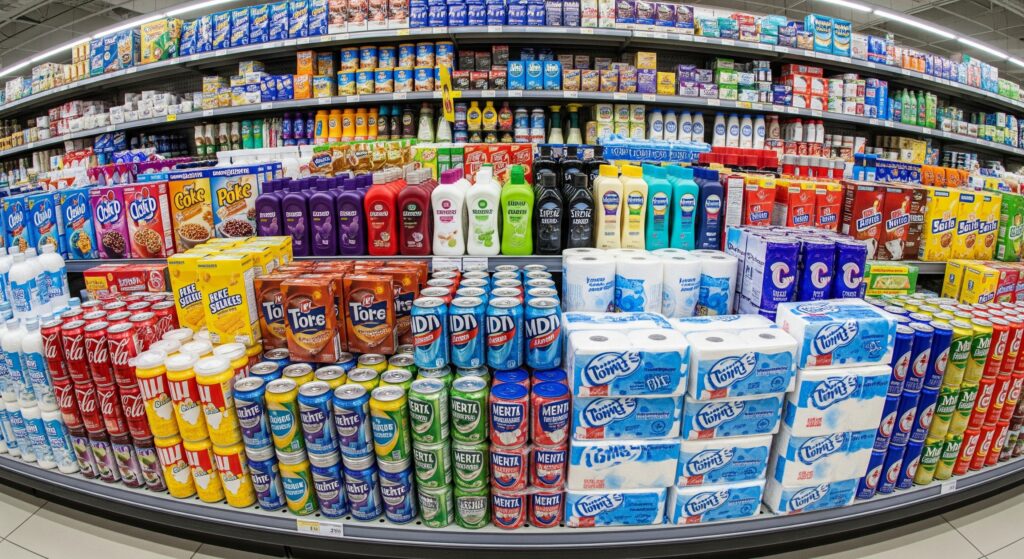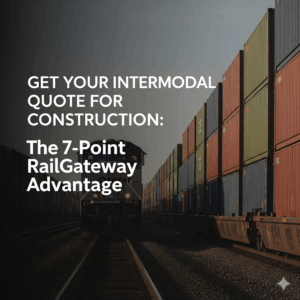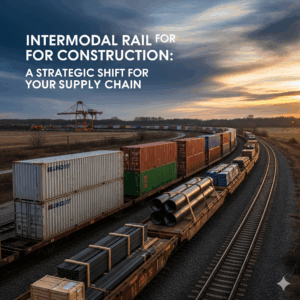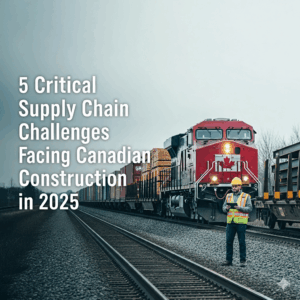From Evaluation to Execution
You have reached the final and most important stage of your journey to optimize your retail supply chain. You’ve moved from understanding the high-level benefits of intermodal rail shipping to a detailed analysis of how it compares to your current trucking strategy. The business case is made. The conclusion is clear: to build a more cost-effective, reliable, and sustainable CPG supply chain, integrating a multi-modal approach is a strategic imperative.
The question is no longer “Why?” but “What’s next?” How do you take this strategic decision and turn it into a smooth, successful, real-world execution?
This guide is your implementation plan. It is a practical, step-by-step playbook designed to demystify the entire process, from getting your first quote to watching your first container of CPG products arrive on-time and intact. We will walk you through seven clear, actionable steps that will remove any remaining uncertainty and empower you to move forward with confidence. By the end of this article, you will have a complete roadmap for securing a competitive quote and launching a successful partnership.

The 7-Step Guide to Your First CPG Shipment
Laying the Foundation for Success
The most successful logistics strategies are built on a foundation of clear data and strong partnerships. These first steps are the most critical in ensuring a smooth and cost-effective launch.
Step 1: Assembling the Right Data for an Accurate Quote
The most common point of failure in sourcing transportation is providing vague information. A vague request leads to a vague price. To get a firm, reliable quote that you can build a budget around, you must first assemble a clear and detailed picture of your shipping needs. Before you fill out a single form, gather the following:
- 1.1. The Specific Lane: “Ontario to Alberta” is a start, but “Postal Code L6T 5S5 to Postal Code T4A 0V3” is what’s needed. The price of the first- and last-mile trucking (drayage) is calculated based on the exact distance from the rail terminals, so precise postal codes are non-negotiable for an accurate door-to-door quote.
- 1.2. The Exact CPG Commodity: “Consumer goods” is too broad. Be specific. Are you shipping “palletized bottled water,” “boxed breakfast cereal,” or “paper towels”? Different products have different weights, densities, and handling characteristics which can influence pricing and equipment needs. Being specific ensures the quote is accurate for your exact product.
- 1.3. Precise Weight and Pallet Count: Provide the total shipment weight, including the product, packaging, and pallets. This is vital for ensuring the load is compliant with legal weight limits on both the highway and the railway. Also, specify the exact number of pallets. This confirms that your shipment will fit within a standard 53-foot intermodal container, which can typically accommodate up to 26 standard pallets (48″x40″) and a maximum weight of around 44,000 lbs.
- 1.4. Shipment Frequency and Volume: A logistics partner needs to understand the potential scale of your business. Are you looking for a one-time “spot quote” to test a lane? Or are you planning to ship 10 containers a week on this lane for the next year? This context is crucial. Consistent, high-volume freight allows a partner to negotiate dedicated capacity and more favorable “contract rates” with the railroads, which can offer significant savings and service guarantees compared to the transactional spot market.
Step 2: Understanding the Components of Your Intermodal Quote
Once you submit your detailed request, you will receive a quote that breaks down the total cost. Understanding these components gives you the power to compare different options transparently and appreciate where the value lies.
- 2.1. The Line-Haul Rate: This is the core charge for the rail portion of the journey, moving your container between the origin and destination rail terminals. On a long-haul lane, this component will be significantly lower than a truck’s line-haul rate and represents the bulk of your savings.
- 2.2. The Fuel Surcharge (FSC): Like trucking, rail has a fuel surcharge, but it’s typically much lower and more stable. It’s calculated based on market fuel indexes but is only applied to the rail segment. Because trains are up to four times more fuel-efficient than trucks, this charge is less impactful on your total price, providing a valuable hedge against energy price volatility and protecting your CPG margins.
- 2.3. First- and Last-Mile Drayage: The quote will include the all-in price for the trucking segments at the start and end of the journey. This cost is based on the distance from your specified postal codes to the nearest rail terminals.
- 2.4. Potential Accessorials: “Accessorials” are fees for services beyond standard transport. A transparent quote will list potential charges so you can avoid them. In CPG logistics, this could include:
- Detention/Wait Time: If a drayage driver has to wait longer than the standard free time (usually 1-2 hours) at your plant or at the retailer’s DC to be loaded/unloaded, fees can apply. This is why having your shipment ready and coordinating with the receiver is so important.
- Drop-and-Hook Fees: If you require a “drop and hook” program where a driver drops a container in your yard for you to load at your leisure, there may be a daily fee for the use of the chassis.
Understanding this structure allows you to have an intelligent conversation about your costs and see exactly how intermodal rail shipping delivers value for your retail supply chain.
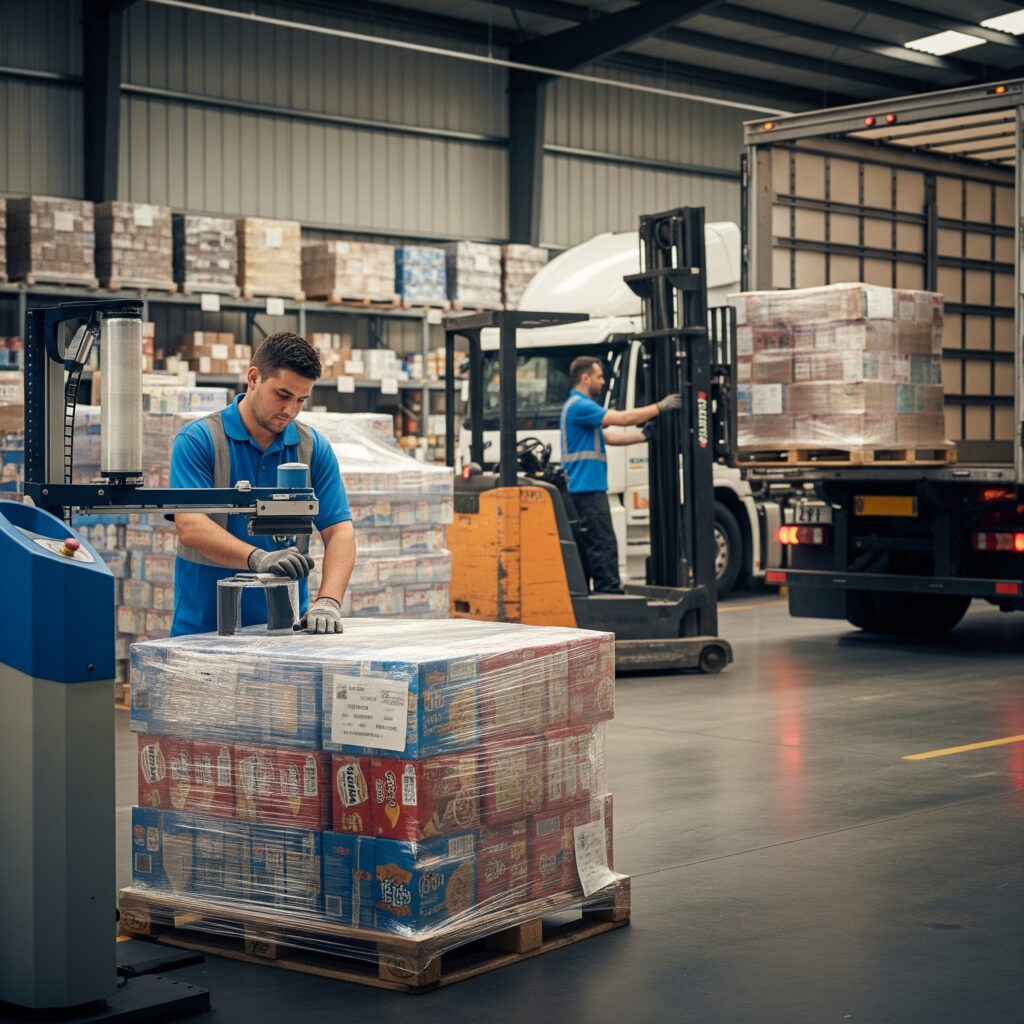
The Engagement & Preparation Phase
With a clear understanding of your data and the costs involved, the next phase is about formalizing a partnership and preparing your physical product for its journey. These steps are crucial for a smooth, damage-free execution that meets the high standards of the retail industry.
Step 3: Selecting a Logistics Partner Who Understands Retail
Choosing your logistics partner is the most important decision you will make. For a CPG company, you don’t just need an intermodal provider; you need a partner who speaks the language of retail and understands the immense pressure you are under. As you evaluate your options, ask pointed questions based on these critical capabilities:
- 3.1. Deep Familiarity with Major Retailer DCs. Does the partner have extensive experience delivering into the major retail distribution centers for customers like Walmart, Loblaws, Sobeys, Costco, and Amazon? These facilities have notoriously strict rules and appointment scheduling systems. A partner who understands the intricacies of securing a Must-Arrive-By-Date (MABD) appointment and knows the operational quirks of each DC is invaluable. Their experience is your best defense against the costly chargebacks that result from missed appointments.
- 3.2. A Robust Drayage Network in Key CPG Hubs. The reliability of the first- and last-mile trucking is paramount. Your partner must have a deep and reliable network of drayage carriers in the regions that matter most to your business—both around your manufacturing hubs (like the Greater Toronto Area) and around the major retail DCs (like Calgary, Vancouver, and Montreal). This ensures that a qualified driver with the right equipment (a chassis) is always available to handle your pickups and deliveries, even during peak seasons.
- 3.3. Technology Built for a High-Volume Environment. CPG logistics often involves managing hundreds or thousands of shipments. You need a partner whose technology can support this scale. Look for a clean, easy-to-use online portal (a Transportation Management System or TMS) that allows you to request quotes, book shipments, track your freight in real-time, and manage all your documentation and invoicing in one place. This simplifies your administration and gives you the visibility you need to manage your retail supply chain effectively.
- 3.4. A Single, Accountable Point of Contact. The last thing your team has time for is chasing down multiple people to find the status of a shipment. A key value proposition of a great logistics partner is providing a single, dedicated account representative. This person is your single point of contact who understands your business, your lanes, and your customers’ requirements. They are responsible for managing the entire door-to-door process, giving you one number to call for any question or update.
Step 4: The Seamless Booking and Onboarding Process
Once you have chosen your partner and accepted a quote, the process of booking your first shipment should be simple and professional. An experienced partner will have a streamlined onboarding process to make this transition effortless.
- Account Creation: Your partner will set up your company in their system, creating a detailed profile with all your locations, contact information, billing details, and any special requirements.
- Tendering the Shipment: To book a load, you simply “tender” the information for that specific shipment. This is often done via a simple email or a form in their online portal. You’ll provide the key details like the Purchase Order (PO) number, the requested pickup date, and the final delivery address.
- Partner Execution: This is where your partner takes over. They handle all the complex backend coordination: they electronically book the container reservation with the railroad, dispatch a drayage carrier from their network for the pickup, generate the master Bill of Lading (BOL) for the entire move, and schedule the final delivery.
- Confirmation: You receive a single, clear booking confirmation that summarizes all the details, confirming that your shipment is officially scheduled for execution. Your experience is simple and efficient because your partner is managing the complexity behind the scenes.
Step 5: Flawless Shipment Preparation for CPG Products
The final step before your product begins its journey happens on your own warehouse floor. The way your CPG products are palletized and loaded is the single biggest factor in preventing in-transit damage.
- Build a Solid Foundation with High-Quality Pallets: Start with high-quality, 4-way entry GMA pallets (48″x40″). Inspect them for any broken boards or protruding nails. A weak pallet is a primary cause of load failure. Ensure your product boxes do not overhang the edges of the pallet, as this can lead to damage and can be a reason for rejection at a strict retail DC.
- Stack for Stability: Create a stable, interlocking pattern when stacking your cases, much like a bricklayer builds a wall. This prevents the boxes from shifting. Keep the top layer as flat as possible to allow for potential double-stacking of pallets inside the container.
- Wrap for Unity: Use high-quality stretch wrap and make multiple passes around the entire pallet, including the top and bottom. The goal is for the stretch wrap to bind all the individual cases together, making the entire pallet behave as one solid, stable unit.
- Load for a Secure Journey: Distribute the weight of the pallets evenly throughout the container. A common best practice is the “pinwheel” method of loading, alternating the orientation of pallets to create a tight fit. Use dunnage (like inflatable airbags) to fill any significant empty spaces at the end of the container to prevent the entire load from shifting forward or backward during transit.
- Finalize Documentation: Have two copies of the completed BOL ready for the driver. This ensures a quick pickup and gets your shipment on its way without delay from your facility.
The In-Transit and Final Delivery Phase
With your CPG products expertly prepared and loaded, the journey begins. In this final phase, a professional logistics partner provides the visibility and coordination needed to ensure the shipment’s journey is as smooth as its preparation, all the way to the retailer’s dock door.
Step 6: In-Transit Visibility and Proactive Communication
Once your shipment leaves your facility, it should not enter a “black hole” of information. In a modern retail supply chain, visibility is control. Your logistics partner should provide a technology platform that gives you a clear window into your shipment’s progress from start to finish.
- Tracking Key Milestones: You should expect to see real-time updates on a series of critical events, allowing you to track the container’s progress across the country. Key milestones include:
- Origin In-gate: Confirmation that your container has been received at the origin rail terminal.
- Train Departure: Your shipment is officially on the move.
- ETA Updates: You will receive regular updates on the Estimated Time of Arrival at the destination terminal.
- Destination Arrival: The train has arrived, and your container is being unloaded.
- Available for Delivery: The container is ready for the final-mile drayage driver to pick it up.
- Destination Out-gate: The local truck has retrieved your container and is en route to the retail DC.
- Proactive Exception Management: Technology is important, but a true partner provides a service beyond a simple tracking portal. Their operations team should be proactively monitoring your shipments. If a rare event occurs, such as a potential rail delay, they will be the ones to identify it, assess the impact on your delivery appointment, and proactively communicate with you and the receiver with a plan to mitigate any issues. This managed approach lets you focus on your business, confident that an expert is overseeing the journey.
Step 7: Coordinating the Delivery at the Retail DC
The final mile is often the most critical. The delivery to a massive, fast-paced retail distribution center is a highly coordinated event where mistakes can be costly.
- The Crucial Delivery Appointment: Your logistics partner manages the crucial process of securing a delivery appointment with the retailer’s DC. They understand the specific scheduling systems and requirements for each major retailer. By securing a firm MABD (Must-Arrive-By-Date) appointment, they ensure the drayage driver arrives at a time the DC is expecting them, preventing your shipment from being rejected and hit with chargeback fees. This professional coordination makes you a more reliable and preferred vendor in the eyes of the retailer.
- Closing the Chain of Custody: Upon arrival at the DC, the receiver will perform two key actions to finalize the shipment:
- Verify the Seal: They will check the high-security seal on your container to ensure the number matches the one recorded on the Bill of Lading. This confirms the load was not tampered with during transit.
- Sign the Proof of Delivery (POD): After unloading and inspecting the freight, the receiver will sign the driver’s Proof of Delivery. It is crucial that any potential damage be noted on the POD before signing. A clean, signed POD confirms the shipment was received in good order and officially completes the successful delivery cycle.
Your Strategic Partner for CPG Supply Chain Success
Making the strategic move to intermodal rail shipping is one of the most impactful decisions a CPG company can make to protect its margins and strengthen its position with major retailers. The process, when broken down into these seven manageable steps, is not a complex hurdle but a clear and professional pathway to a more efficient and resilient operation. From the initial data gathering to the final, signed proof of delivery, a structured approach managed by an expert partner ensures a flawless execution.
This process is the key to unlocking the immense benefits of a modern multi-modal strategy. It is how you build a retail supply chain that can withstand seasonal capacity crunches, deliver on stringent OTIF requirements, and meet the growing demand for sustainable logistics. The time for analysis is over. The path to implementation is clear.
You have done the research. You know the benefits. The final step is to see the real numbers for your business. Don’t let another quarter of volatile truck rates and transit uncertainty dictate your profitability. Partner with an expert and start building a more resilient and cost-effective supply chain today.
Get Your Free, No-Obligation CPG Shipping Quote Now
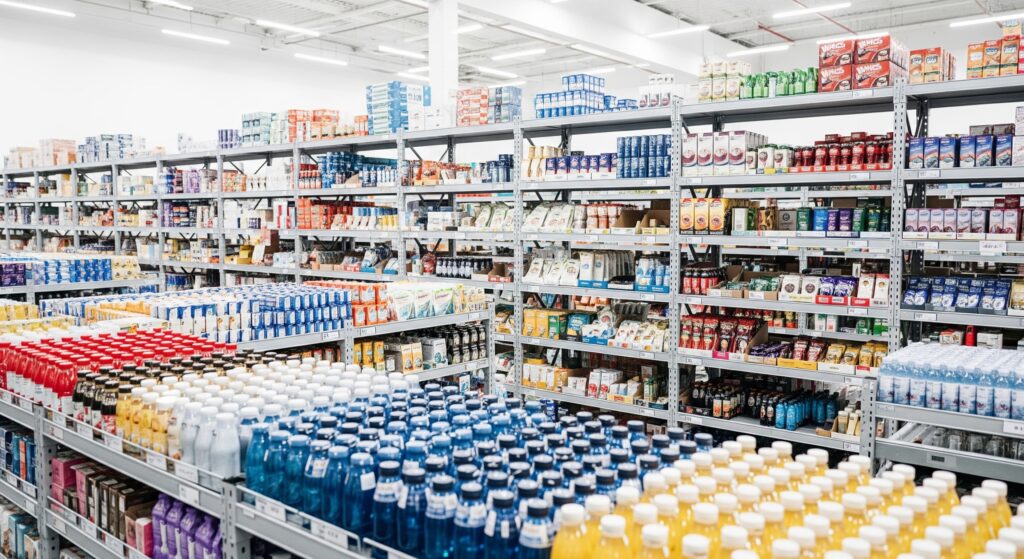
Additional Resources:
Intermodal Shipping with RailGateway
Intermodal Shipping for Retail & Consumer Packaged Goods
Retail Council of Canada (RCC)
